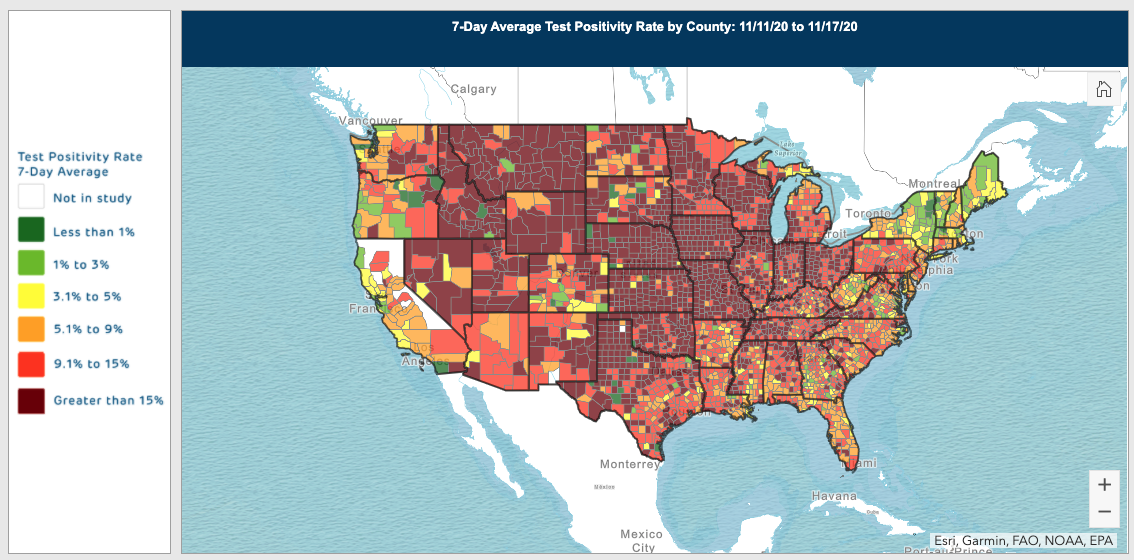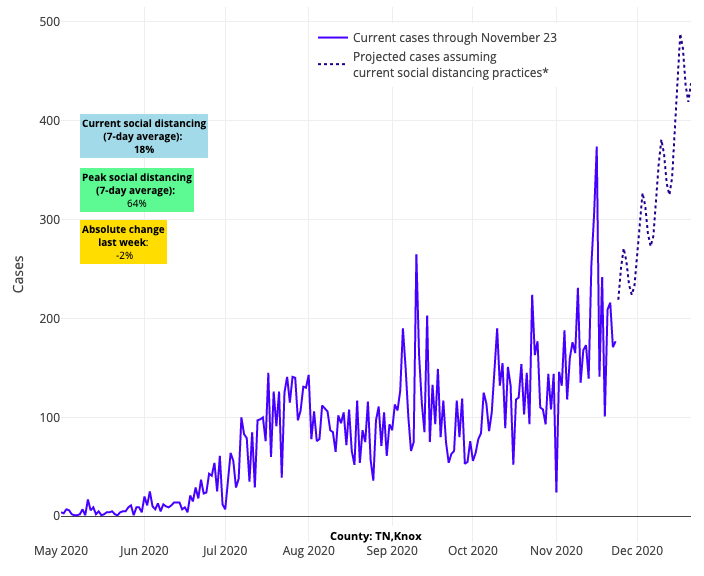COVID-19 Outlook: A Week of Travel and Uncertainty as a New Chapter Begins
Below are the top-line findings from our weekly COVID-Lab forecasting model update:
-
Testing positivity rates across the country averaged 12.4% this week, down 0.8% from last week.
- We noticed this decline in testing positivity rates, as well as transmission rates (“Rt”), most clearly in the Midwest (Illinois, Michigan and Minnesota) and in Colorado—areas that first experienced the worst of this fall wave.
- Eighty-two percent of the 821 counties we follow, however, are now exceeding 200 weekly cases per 100,000 residents.
- The top 10 states with the greatest growth in testing positivity rates includes four Northeastern states (New York, New Hampshire, Pennsylvania and Delaware), two Sun Belt states (Arizona and New Mexico), one state in the Pacific Northwest (Washington), and two Mountain West states (Utah and Wyoming). The fall surge has clearly moved well beyond the Midwest.
- All major cities in the Northeast are now seeing over 250 weekly cases per 100,000 individuals, excepting New York City, which is recording more than 150 weekly cases per 100,000 individuals in each of its five boroughs (and has surpassed 300 weekly cases per 100,000 individuals in Staten Island).
- The major cities on the West Coast and in the Sun Belt (Phoenix, San Diego, Los Angeles, Sacramento Portland and Seattle) have now all surpassed 200 weekly cases per 100,000 individuals, except San Francisco, which remains below 100 weekly cases per 100,000 individuals.
- Notably, we project case incidence will increase over the next four weeks in the following metropolitan areas (cities and collar counties): Sacramento, Indianapolis, Detroit, Cincinnati, Cleveland, Akron, Pittsburgh, Dallas and Las Vegas.
- Our projections for the Philadelphia region, our hometown, continue to forecast growth in incidence rates. However, within the city limits the projected tempo of increased transmission appears to be less than in Philly’s collar counties.

Above is the 7-day nationwide positivity rate graph by county.
As we consider these findings, we are cautiously optimistic that some of the stabilization in positivity rates that we are witnessing might be due to:
- Implementation of community-focused mitigation efforts starting to have an effect
- An awareness of increasing hospitalizations and deaths leading many to avoid larger gatherings of friends and family
- Individuals consciously deciding to limit their contacts with others in advance of a family holiday
Of course, we must also recognize the real possibility that the deceleration of test positivity rates is the result of an increased number of asymptomatic individuals seeking testing in advance of the Thanksgiving holiday. As such, it’s important to consider positivity rates alongside the rise in case incidence we are reporting. These high rates heading into the holiday weekend provide the potential for significant transmission among family members gathering for Thanksgiving.
Importantly, not all areas are experiencing stabilizing test positivity and incidence rates this week. For example, testing positivity rates are growing in almost every county across New York. New Hampshire is much worse than it was a few weeks ago. In Pennsylvania, we anticipate case counts and hospitalization rates will continue to rise steeply over the next four weeks. Finally, our concern remains heightened for the Mid-Atlantic and Southeast, including the Carolinas, Tennessee and Georgia, where test positivity, case incidence and hospitalization rates are all on the rise. Lack of commitment to mitigation efforts during the Thanksgiving holiday weekend could lead to further escalation of these numbers well into December.

Above are the projections for Knox County (Nashville) in Tennessee.
As we emerge from the Thanksgiving holiday, there is risk for significant acceleration of the pandemic. However, as we have said before, this fate is not predetermined and we have some control over what is to come. We hope that your weekend will offer time for relaxation and enjoyment amidst these challenging times. We just urge that you limit your gathering sizes and take the necessary steps to protect the vulnerable members of your families. Certainly this is not the way we want to celebrate Thanksgiving, but if we can limit transmission this weekend we will keep our families strong for the many gatherings on the horizon in 2021.
From our team at PolicyLab, we wish you a happy and safe holiday weekend!

